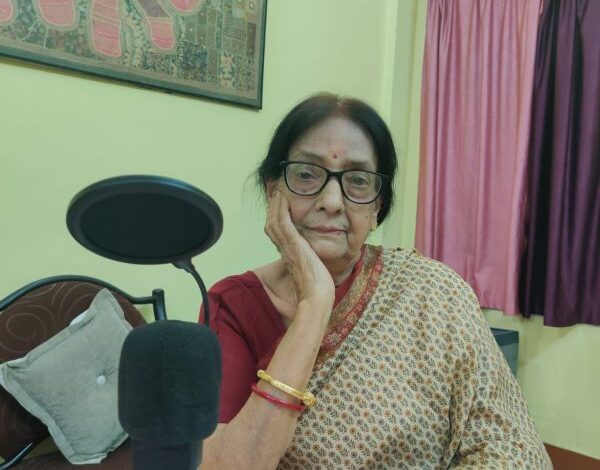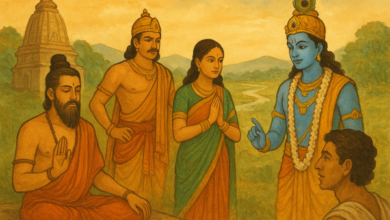An author’s journey through folktales
A vegetable vendor's story piqued Sobhona Bhattacharjee’s interest in folktales of different tribes and communities

 An author, elocutionist and a natural storyteller — Sobhona Bhattacharjee has many facets. But what is endearing about her is her ability to effortlessly speak to a stranger and make the person feel at ease. Probably, it is this quality that helped her converse with people from every stratum of society and all communities to collect fragments of their oral history and weave those into priceless collections of folktales.
An author, elocutionist and a natural storyteller — Sobhona Bhattacharjee has many facets. But what is endearing about her is her ability to effortlessly speak to a stranger and make the person feel at ease. Probably, it is this quality that helped her converse with people from every stratum of society and all communities to collect fragments of their oral history and weave those into priceless collections of folktales.
Recently, Bhattacharjee’s collection of folktales from Meghalaya was translated into English. Her keen interest in folktales began in Shillong, where she spent 51 years of her life.
The octogenarian writer, who has authored several books in Bengali, grew up in Guwahati in the 1940s. In her book Purono Guwahati (Old Guwahati), she reminisces about the small town and its simplicity, Harisabha and Durga Puja and shares anecdotes of her childhood and youth.
Bhattacharjee came to Shillong in 1965 after marriage. She taught at Shillong Academy and St Edmund’s School. During her stay in the hill city, she would interact with vendors, students and locals to know about folktales.
“One day, a vegetable vendor came to my doorstep. I would often strike up a conversation with him, ask him about his village and family. Once, he narrated a story to me, and I immediately understood that he was telling me a folktale. It instantly struck me that hill tribes were bound to have folktales. This piqued my interest. It was the beginning of a journey through folktales,” Bhattacharjee told Sunday Monitor on the phone from Silchar, where she currently lives with her daughter, a doctor by profession.
In 1969, she started writing for various publications. The first story was collected from a Khasi bureaucrat, one Mr Pariat, in Shillong. She wrote for Sambad Lahari, Jugasankha and Sanglap (a little magazine), among others.
“I collected many stories from my students. I would ask them to find out about folktales from their parents, and they helped me a lot,” said the author.
Folktales are a part of a community’s oral history. They are not mere stories but a way to understand a tribe or a community’s tradition, practices, rituals, spirituality and beliefs, which are rooted in its evolutionary history. Bhattacharjee’s new book, Folktales from Meghalaya (translated by Utsa Bose), has stories from the Khasi, Garo and Jaintia Hills.
That these folktales evolved through generations and storytellers, who would modify their narratives keeping the essence of the stories intact, is evident from the similarity that one finds in different collections of folktales. For instance, Bhattacharjee’s The Peacock and The Sun, a folktale from Jaintia Hills, can also be found in KU Rafy’s collection of tales. Rafy was the first Khasi writer to collate Khasi folktales. However, the narratives of the two stories are different.
 When asked whether Rafy had inspired her and helped her in her research, Bhattacharjee answered in the negative. Her sources of tales were the hoi polloi whom she would meet in Shillong and while travelling.
When asked whether Rafy had inspired her and helped her in her research, Bhattacharjee answered in the negative. Her sources of tales were the hoi polloi whom she would meet in Shillong and while travelling.
Bhattacharjee’s ability to easily connect with people helped her in her long journey of collecting folktales not only from Meghalaya but also from other Indian states, as well as different countries.
“I collected stories from people whom I met on the way to Guwahati from Shillong, on the train while travelling and several people whom I met over the years. My domestic help also told me several stories,” she said, adding, “Folktales are the roots of any literature in any language. Hence, my deep interest in folktales.”
Renowned photographer Ahmed Husain, who passed away in April this year, had a special mention in Bhattacharjee’s interview. She said it was Husain who helped her gather several folktales of Mizoram. “He was of great help. I did not know about his passing away. I am deeply saddened by the news,” she said in a poignant voice.
Her book, Desh-Bidesher Lokokotha (Folktales from India and Around the World), has folktales of the Santhals and from Nagaland, Nepal and Scotland.
According to Bhattacharjee, folktales are important to understand a community and know its history and traditions. She also underlined the importance of folktales in popularising and preserving a language.
“Many tribal languages are becoming extinct. With that, we are losing their tales too. So, these folktales must be translated and popularised. This can be a way to save a language too,” Bhattacharjee said.
“The hill tribes love music. If they can write down these songs in English, then many people will know about them. Similarly, if each one of us learn something about their languages and tries communicating in their languages, then we will all contribute to protecting a particular language. Now, English has become a prevalent language. But if they speak more Khasi in the city, then non-Khasis will also pick up the language faster,” she added.
After folktales, Bhattacharjee is now focusing on fairy tales and memories of Shillong. “I just finished a fairy tale. This is the first time I am writing fairy tales. Let’s see how it goes,” said Bhattacharjee.
She is also planning to write about Shillong, the place where she spent more than half a century, and where she first started exploring folktales. Talking about the changing face of the beautiful hill town, Bhattacharjee said change is unavoidable, and “we have to accept it, whether we like it or not”.
“True, that Shillong has changed a lot. I have reminisced about the old town in my book. Earlier, when we would visit Shillong during my childhood, we would get the smell of pine from Barapani. But now, you won’t get the smell. Also, the old wooden houses are vanishing, giving way to concrete houses. This is sad, but we have to also accept the fact that wood is precious now. While some places in Shillong have remained as is, many have undergone a sea change,” she remembered.
Bhattacharjee is a prolific writer. Besides folktales, she has written plays and short stories. However, her eye problem has become a hindrance. She is also into recitation, and despite her age, she regularly participates in cultural events. What is striking about her is her exuberance that is beyond imagination. For her, age is akin to wisdom and not weakness. At a level, her energy is contagious. Her love for literature and her deep interest in knowing different cultures keep her busy.
“I hope my eyes will be better, so that I can continue writing without much trouble,” she said. Every reader of her book will be wishing the same, so that the author can share more stories from around the world and of times gone by.





